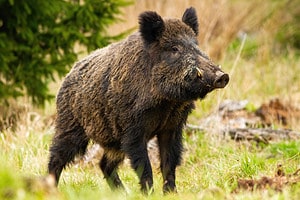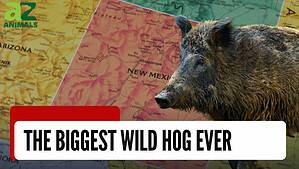Feral hogs, also known as wild boars or wild hogs, are an invasive species that have proven remarkably resilient and adaptive.
In this article, we will explore feral hogs, specifically in Arizona, where they roam, and the danger they pose to humans and the native ecosystem.
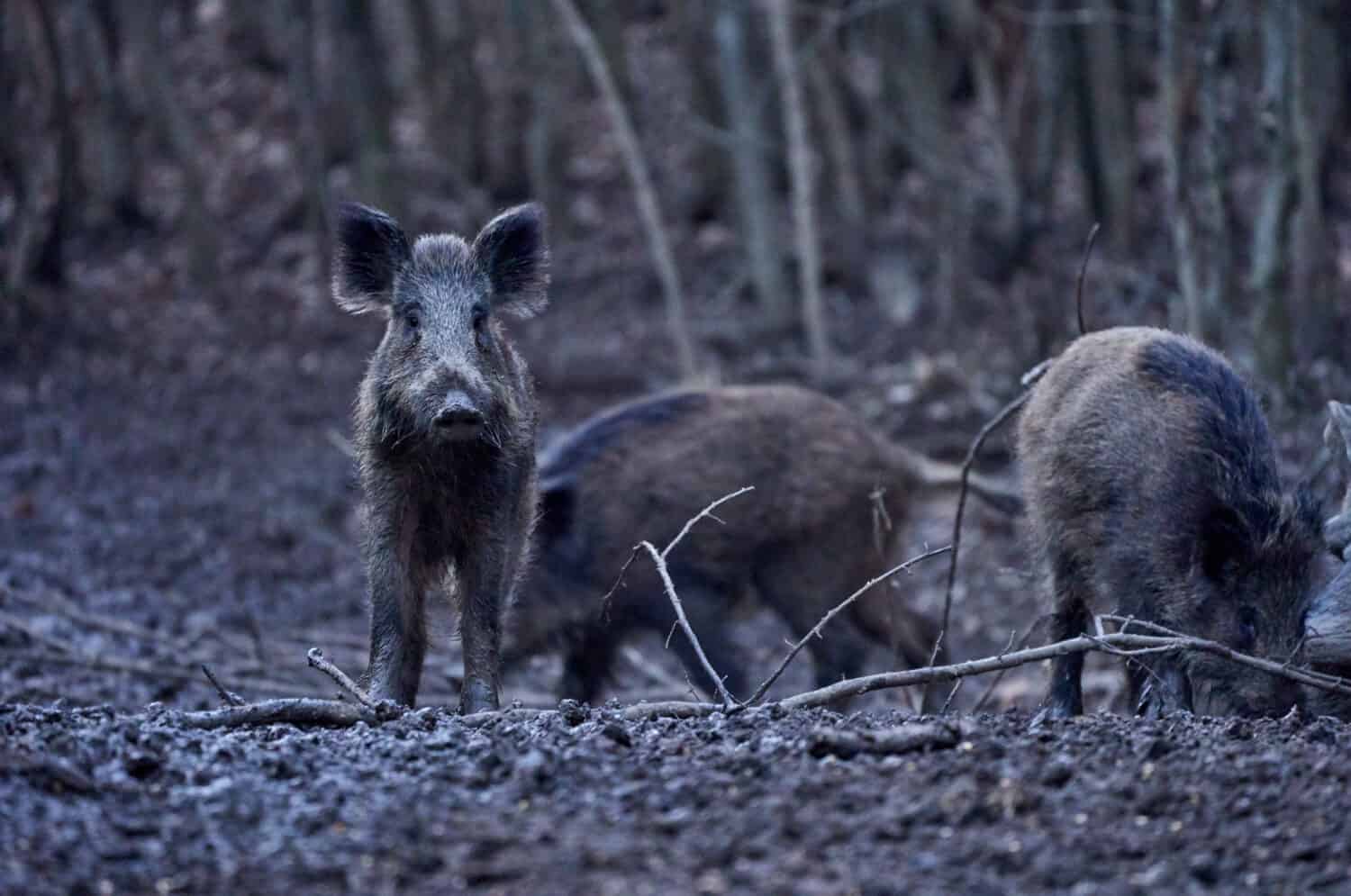
Feral hog populations in Arizona are quite low, though not fully eradicated.
©Slatan/Shutterstock.com
Feral Hog Population in Arizona
Estimating the population of feral hogs is a challenging task. There isn’t a credible estimate of the population of feral hogs in Arizona. However, the consensus is roughly 1,000, which is a broad estimate.
Feral hogs are a damaging invasive species that threaten native wildlife, destroy agricultural lands, and cause environmental degradation. These omnivores feast on a diet as diverse as their habitats, including plants, small animals, and even carrion. Their adaptability, however, can lead to problems. As feral hogs are non-native, they can upset the balance of local ecosystems. They compete with native species for resources, damage vegetation through their feeding habits, and potentially spread diseases to other wildlife, livestock, and humans.
The situation of feral hogs in Arizona has been complicated, highlighting the delicate balance of biodiversity and the unintended consequences of species introduction. Nevertheless, the efforts of local and federal wildlife departments in monitoring and managing these populations are instrumental in maintaining this balance.
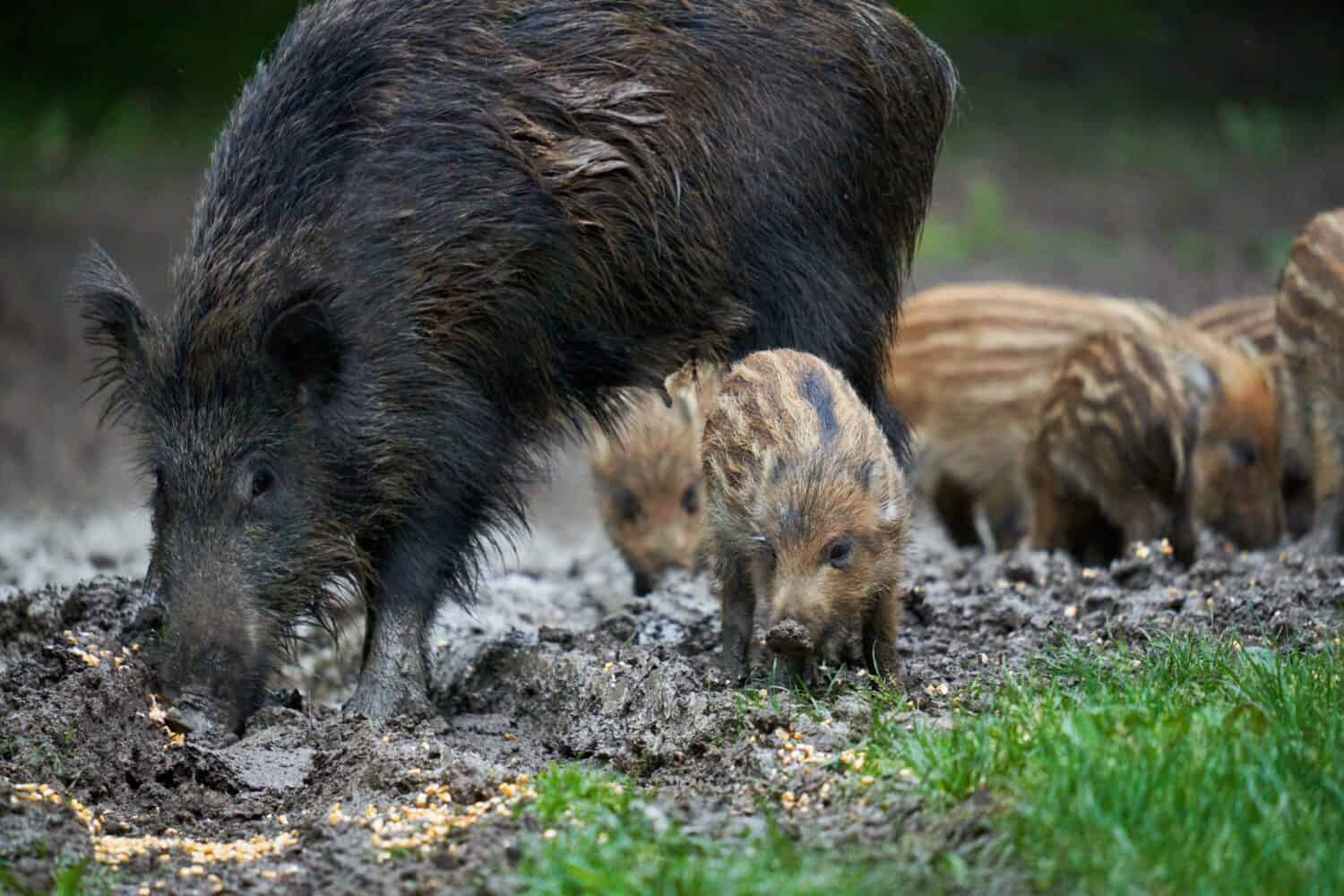
Feral hogs are an invasive species in the United States.
©Slatan/Shutterstock.com
Management of Feral Hogs in Arizona Has Been Extensive
Feral hogs are a resilient species that have managed to make a home for themselves in the diverse landscapes of Arizona. But this new “home” is not without its challenges. These hardy animals have stirred up quite a ruckus in the ecological sphere, necessitating the implementation of various control measures.
Management of Feral Hogs in Arizona Has Been Extensive
Managing feral hogs in Arizona is a multifaceted approach comprising small-scale exclusion methods, trapping, and shooting from both the ground and the air. Each of these strategies has its own merits. However, they’re not all equal in effectiveness when it comes to curbing the wild pig population growth.
The more strategic methods, like trapping and aerial shooting, have proven most effective in controlling and reducing feral hog numbers in Arizona. Trapping can catch multiple hogs at once, often entire family groups known as sounders. At the same time, aerial shooting allows for broader coverage of areas otherwise difficult to access.
Despite the effectiveness of these measures, long-term success has hinged on a cooperative effort involving private property owners. The concept is simple: by working together to reduce the feral hog population size across a wider area, there has been less chance for the hogs to repopulate from neighboring lands.
Arizona Has Had Success in Reducing Their Feral Hog Populations
The timeline from around 2010 through the present reveals a story of resilience and determination. Arizona has demonstrated notable success in diminishing its feral hog populations during this period. Despite these creatures being able to inhabit a variety of areas, including the San Pedro River, Willcox, and the Arizona Strip, persistent efforts have kept their numbers in check. But by all measures, Arizona has been successful in reducing its feral hog population. For example, by 2022, relentless efforts had nearly wiped out the feral hog population in the Lake Havasu National Wildlife Refuge, marking a significant victory for Arizona’s biodiversity.
Among these locations, the burgeoning population in Navajo County raises concern. In contrast, the feral hog population on the Colorado River in the previously mentioned Havasu National Wildlife Refuge is teetering on the edge of eradication, a testament to the success of the implemented control measures.
Arizona’s Goal Is the Full Eradication of Feral Hogs
Arizona’s ultimate goal, however, is not just management but the complete eradication of feral hogs. This goal might seem like an audacious mission. However, it is a necessary one for the preservation of Arizona’s rich biodiversity. This mission is not a solitary endeavor. It involves the partnership of several entities, including the U.S. Fish and Wildlife Service, the Arizona Game and Fish Department, and the Arizona Department of Agriculture.
Also crucial to this mission is the USDA-APHIS Wildlife Services National Feral Swine Damage Management Program. This program, along with several other land management entities, offers its expertise and resources to combat the havoc wreaked by these invasive creatures.
Their concerted efforts aim to remove this invasive species and mitigate the damage they cause. From trampled farmlands and ruined crops to the disturbance of native wildlife habitats, the damage caused by feral hogs is extensive and far-reaching.
Beyond the environmental and agricultural implications, the eradication mission also has an economic dimension. The destruction wreaked by feral hogs results in substantial financial losses for farmers and landowners. Hence, removing these animals also helps protect the state’s agricultural economy.
Reduction Is an On-Going Process
The journey towards a feral hog-free Arizona is certainly not a sprint but a marathon. Its progress is evidence of the resilience and dedication of those involved in wildlife and natural resource management. And it is a continued commitment to protecting and preserving the diverse, unique, and beautiful ecosystems that make Arizona a vibrant place for wildlife and people.
As we move forward, remember that every creature has a place in the grand circle of life. However, invasive species are named because they are not native to the habitats they may inhabit and cause disruption to the natural ecosystem. So, we must take measures to restore equilibrium when a species like the feral hog starts pushing the boundaries, disrupting the balance, and causing more harm than good. Through the combined efforts of various organizations and individuals, Arizona is on the right track to eradicate feral hogs from its boundaries fully.

Feral hogs are not commonly sighted in Arizona as their population numbers are quite low.
©ROBERT ENRIQUEZ/Shutterstock.com
Can You Hunt Feral Hogs in Arizona?
Interestingly, Arizona does not impose specific laws or regulations regarding feral hog hunting. However, this does not imply an open season for wild pigs, also known as Javelina, which is an entirely different species. A general hunting license is a requisite for anyone who wishes to hunt anything, serving as a measure to maintain ethical hunting practices.
Natural resource management agencies in the state have clearly labeled feral hogs as a nuisance. The reasons for this are manifold. Feral hogs compete with native wildlife for resources and potentially spread diseases. They can cause extensive damage to the environment and agricultural lands. Therefore, these agencies advocate for their removal.
Hunting Feral Hogs in Arizona Is Not Common
However, it is worth noting that feral hog hunting isn’t a popular sport in Arizona today because it is rare to encounter. Recreational hunting might appeal to the adventurous spirit of Arizonians and visitors alike, offering a challenging hunting excursion in the state’s scenic wilderness. Yet, this method isn’t common due to the sparse population of feral hogs here. It certainly falls short of putting a significant dent in the already dwindling population.
Arizona State and United States entities have done an excellent job at lessening populations and moving toward total eradication in Arizona. If feral hog hunting is of interest, the best states for recreational hunting would be Texas, Oklahoma, Florida, Louisiana, and Georgia, as their populations are rampant and hunting opportunities are generous.
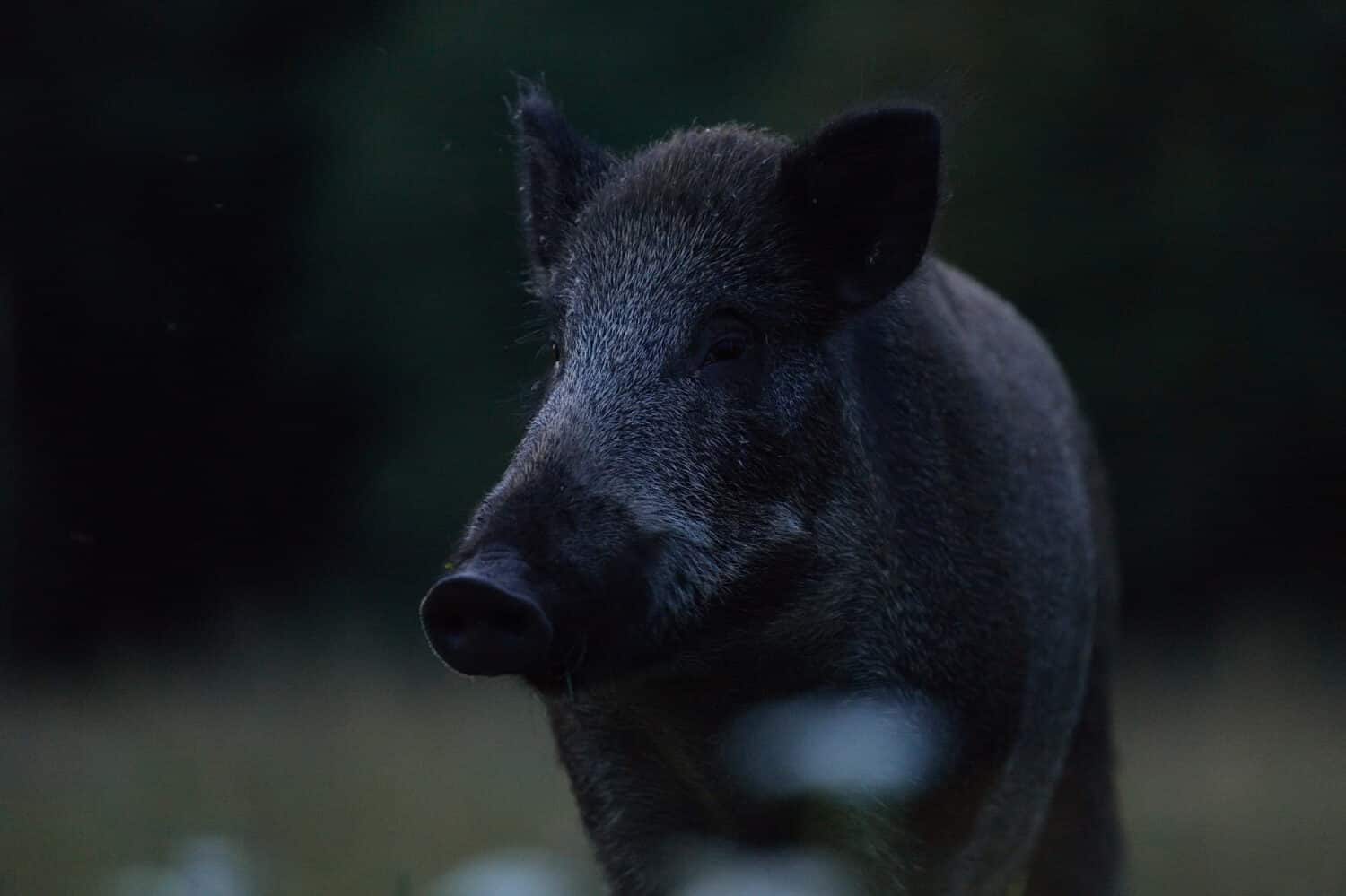
Hunting feral hogs in Arizona is legal with a general hunting license.
©Erik Mandre/Shutterstock.com
Why the Feral Hogs in the United States Is an Invasive Species
Feral hogs, recognized by their rugged appearance and adaptability, have a complicated relationship with their adopted home in the United States. Arizona, with its diverse landscapes, has yet to escape the pressing issue of these invaders. But what exactly makes these robust creatures an invasive species?
In the ecological world, an invasive species exhibit the characteristic of establishing, spreading, and causing damage in an environment where it is not native. And feral hogs check all these boxes.
Feral Hogs Were Introduced to the United States in the 16th Century
Firstly, Spanish and European explorers introduced them for hunting and farming purposes, tracing their arrival in the United States back to the 16th century. This makes them non-native to the land, a key criterion in defining an invasive species.
Their remarkable adaptability fuels their ability to establish and spread. Feral hogs are survivors capable of living in a range of environments, from dry, arid regions to dense forests. Their omnivorous diet adds another feather to their survival cap, letting them consume almost anything that comes their way.
The ability of feral hogs to reproduce rapidly further aids their invasion. Sows can begin breeding as young as six months old and produce two litters of four to six piglets yearly. This swift reproductive cycle has allowed their population to skyrocket in a short period.
They Are Destructive
The ‘damage’ aspect of being an invasive species is where feral hogs make their mark. They are known to cause significant harm to the local ecosystems. They compete with native species for food and habitat, upsetting the ecological balance. Their feeding activity can lead to soil erosion and negatively affect water quality. They can also spread diseases affecting wildlife, livestock, humans, and pets.
In Arizona, feral hogs considerably threaten the state’s unique biodiversity. We’ve discovered that they have shown a troubling presence in locations including the San Pedro River, Willcox, and the Arizona Strip. The growing population in Navajo County has been a cause for concern. And as for the severe economic implications, their rooting and wallowing behavior can dramatically damage agricultural lands. This inflicted damage can lead to consequential financial losses for farmers and landowners.
Thus, feral hogs have earned their status as an invasive species through their non-native origins, impressive adaptability, rapid reproduction, and the widespread damage they inflict on the natural environment and human activities. Their presence in Arizona and across the United States is a challenge that requires continuous efforts from wildlife and land management agencies to protect the native ecosystems and maintain the balance of nature.

Feral hogs can harm livestock through the transmission of diseases.
©ROBERT ENRIQUEZ/Shutterstock.com
Are Feral Hogs Dangerous?
Feral hogs pose considerable threats to humans, wildlife, and the environment, making them a significant concern for biodiversity and ecological balance.
Feral Hogs Are Aggressive
When it comes to human interaction, feral hogs typically aren’t seen as a direct threat. However, they can become aggressive if cornered or when a mother hog, known as a sow, protects her young. Accidents involving vehicles hitting feral hogs on roadways can also pose significant dangers to humans. These incidents often lead to property damage and can result in serious injuries.
Feral Hogs Transmit Diseases
Feral hogs can also carry and transmit numerous diseases. They are potential carriers of bacterial and viral diseases, some of which are zoonotic, meaning they can be transmitted to humans. Examples include leptospirosis, brucellosis, and trichinellosis. These health risks underline the importance of handling wild-caught hogs carefully and cooking wild boar meat thoroughly.
Feral Hogs Negatively Impact Native Wildlife and the Environment
The impact on native wildlife is another alarming aspect of the feral hog invasion. Feral hogs compete directly with native wildlife for resources such as food and water. This competition can disrupt local fauna populations, particularly those of small game species, ground-nesting birds, reptiles, and amphibians. Additionally, they are opportunistic omnivores, meaning they can and will prey on said ground-nesting birds’ eggs, small mammals, reptiles, and amphibians, causing further disturbances to the ecological community.
Then there’s the environmental impact. Feral hogs rooting behavior, which we briefly reviewed, is their method of foraging in the ground for food. This action loosens the soil and can lead to significant erosion. In areas close to water bodies, this can result in siltation, negatively impacting water quality and aquatic life. Additionally, their wallowing behavior can alter the natural landscape, potentially destroying native vegetation and disrupting local ecosystems.
In Arizona, with its unique blend of ecosystems, the destructive behavior of feral hogs can have catastrophic effects. The sensitive San Pedro River, Willcox, and the Arizona Strip habitats are particularly at risk.
Feral Hogs Can Devastate Agriculture
On top of their ecological impacts, feral hogs also cause extensive agricultural damage. They can devastate crops, harm livestock through the transmission of diseases, and damage property, leading to considerable economic losses for farmers.
The battle against these invasive creatures is, therefore, crucial to protect not only Arizona’s rich biodiversity but also the well-being of its inhabitants and economic stability. The fight continues to mitigate the damage these robust invaders caused and restore the balance they’ve disrupted.
In conclusion, the dangers posed by feral hogs are far-reaching, affecting humans, wildlife, and the environment. Their aggressive behavior, the potential to carry disease, competition with native wildlife, environmental destruction, and economic impact make them a significant concern for conservationists and authorities alike.

Arizona has had success in reducing its feral hog population.
©Chase D’animulls/Shutterstock.com
Conclusion
In summary, the dangers posed by feral hogs are far-reaching. On the whole, they present a significant challenge in the United States due to their invasive nature. However, Arizona has succeeded in its continued efforts to one day eradicate feral hogs from its lands. Feral hogs, while potentially admirable in their survival instincts, pose a significant threat to humans, wildlife, and the environment.
Encountering Feral Hogs in Arizona Is Not Common
Though few and far between, they are found primarily around the San Pedro River, Willcox, and the Arizona Strip areas. In Arizona, anyone can technically hunt them with a general hunting license. However, they are a rare sight and are non-popular hunting game.
They Are Aggressive and Destructive
Their potential aggression towards humans, particularly when they feel threatened, poses a physical danger. Additionally, the diseases they carry, such as leptospirosis, brucellosis, and trichinellosis, underline the health risks associated with their presence.
From an ecological perspective, feral hogs compete directly with native wildlife for resources. Their opportunistic diet and feeding behaviors disrupt local fauna populations and can lead to a reduction in biodiversity. Feral hogs’ rooting and wallowing behaviors have substantial environmental impacts, causing soil erosion, water pollution, and habitat destruction.
Their devastating impact on agricultural lands underscores their economic implications, causing significant financial losses for farmers due to crop and property damage.
In the face of these challenges, the efforts to manage and control the population of these invasive creatures remain critical for the conservation of Arizona’s unique ecosystems, the well-being of its inhabitants, and its economic stability.
It’s clear that while feral hogs are impressive invaders, the consequences of their presence necessitate ongoing, determined, and collaborative management efforts.
Thank you for reading! Have some feedback for us? Contact the AZ Animals editorial team.




